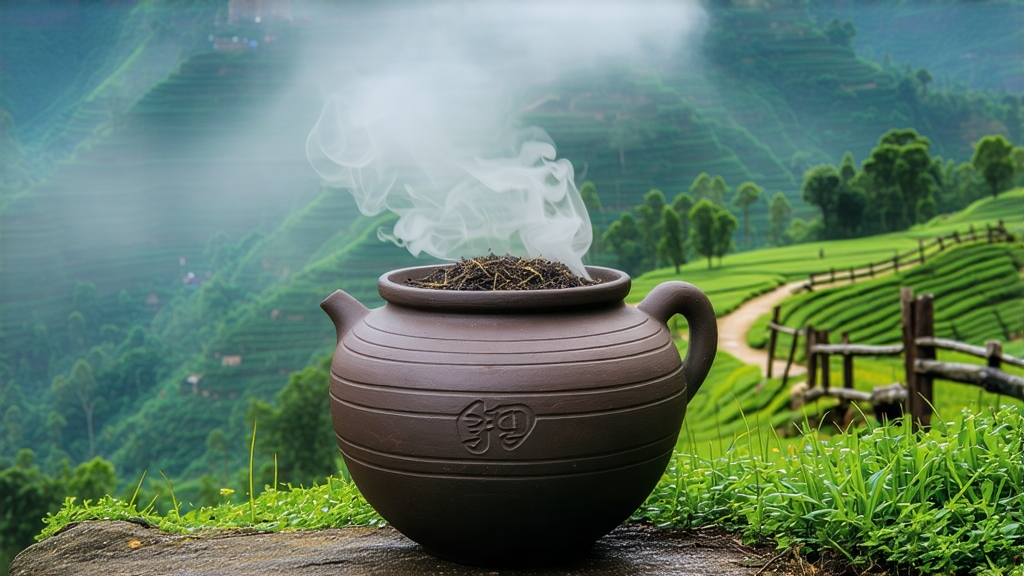
Liu Bao, literally “Six Forts,” is the name of a small market town in the humid, karst-pitted hills of Guangxi Province, but it is also the name of a tea that once greased the wheels of the Qing empire’s border trade and still carries the scent of camphor, betel nut, and old cellars in every cup. To most Western drinkers, Chinese dark tea begins and ends with Yunnan’s shou pu-erh, yet Liu Bao is centuries older than its famous cousin, and its story is etched into the bamboo-leaf wrappings that once protected it on the Tea Horse Road. This essay invites the international reader to step off the pu-erh highway, walk the stone paths of Guangxi, and meet a tea that ferments not only in piles of damp leaves but in the collective memory of merchants, dockworkers, and mountain minorities who still greet guests with a bowl of ink-black liquor that tastes like liquid mahogany.
History: From Frontier Currency to Maritime Ballast
The earliest written record of Liu Bao appears in a 1567 county gazetteer that lists “Cangwu dark tablets” among tributes to the Ming court. At that time the leaves were pressed into thick discs or bricks, wrapped in bamboo husks, and strapped to mule saddles bound for Guangzhou’s Thirteen Factories. By the late 17th century, Liu Bao had become a de facto currency in the mountainous Sino-Vietnamese borderlands; a single 1.5-kilo brick could buy a goat or two iron plowshares. When the British East India Company began purchasing “Bohea” teas in the 18th century, Liu Bao was loaded as low-value ballast in the holds of clippers, its dense, microbe-rich cakes stabilizing ships that later emptied Yorkshire warehouses of porcelain and silk. The tea thus traveled farther than its producers ever imagined, aging in salty darkness as it crossed the Indian Ocean. In 1886, a customs inspector in Penang noted that “the coolies drink a black infusion smelling of wet earth and medicine; they claim it cures ship fever.” That medicinal reputation still shadows Liu Bao today, anchoring it in the Chinese pharmacopeia as a “cut-the-grease” tea for heavy Cantonese dim sum.
Leaf and Place: Micro-terroirs of the Southern Subtropics
Guangxi’s subtropical monsoon climate—90 % humidity, red lateritic soil, and temperature swings between 30 °C days and 15 °C nights—creates an open-air laboratory for endophytic microbes. The indigenous large-leaf variety, Camellia sinensis var. assamica cv. Guangxi Daye, develops leaves as broad as a farmer’s palm, coated in a downy wax that traps ambient yeasts. Three micro-zones matter most: the cool cloud-forest enclave of Gupo Mountain (800–1,200 m), the terraced foothills around Liubao town (200–400 m), and the misty canyon of the Xun River where dock warehouses once held tea for weeks, allowing spontaneous fermentation. Leaves picked above 600 m carry higher amino acids, yielding a sweeter, orchid-like aftertaste, whereas valley leaf is tougher, destined for the wet-pile that generates Liu Bao’s signature “betel-nose” aroma—an earthy sweetness reminiscent of the Areca nut chewed across Southeast Asia.
Craft: The Eight-Step Dance of Fire, Water, and Microbes
Unlike shou pu-erh, which borrows Liu Bao’s wet-pile technique yet shortens it to 45 days, authentic Liu Bao undergoes a leisurely 70–90-day post-fermentation that locals call “returning red.” The eight steps are:
- Pluck: one bud, three to four leaves, after the Qingming rain but before the grain rains.
- Wilt: 4–6 hours on bamboo trays in shaded corridors where mountain breeze reduces grassy volatiles.
- Kill-green: 5-minute tumble in a 200 °C dragon-basket roaster; the leaves must emit a faint popcorn note but remain supple enough to tie into a sailor’s knot.
- Rolling: 40 minutes of alternating light and heavy pressure to rupture 60 % of cell walls without shredding the leaf.
- Sun-dry: spread on concrete courtyards for one full day until moisture drops to 12 %; the red soil dust that inevitably